Lightning Dictionary (Glossary of Terms)
|
In September of 2025, my work is generating the most income it ever has in my career. Yet, I'm being forced to shut down my successul operation, against my will, due to one cause alone: 95% of that revenue is being stolen by piracy and copyright infringement. I've lost more than $1 million to copyright infringement in the last 15 years, and it's finally brought an end to my professional storm chasing operation. Do not be misled by the lies of infringers, anti-copyright activists and organized piracy cartels. This page is a detailed, evidenced account of my battle I had to undertake to just barely stay in business, and eventually could not overcome. It's a problem faced by all of my colleagues and most other creators in the field. |
This is a glossary of lightning terms you'll see when reading this site.
 Anvil Cloud Anvil Cloud
The flat top of a thunderstorm ( cumulonimbus) cloud that spreads out in front of or behind the parent cloud, making the entire system resemble an anvil (pictured at right). The anvil will usually mark the tropopause in the lower atmosphere above which moisture and clouds cannot rise any further. Thunderstorm anvils are often blown up to hundreds of miles away from the parent thunderstorm by upper-level winds, creating a thin, wispy layer of cirrus clouds that signal the storms' presence at great distances.  Anvil Crawlers Anvil Crawlers
Lightning that branches upward and outward like a tree along the tops and sides of large thunderstorms. The lightning seems to 'travel' or 'crawl' across the sky, as in the slow-motion movie at right (click for full-speed mpeg video). Anvil crawlers are also sometimes referred to as ' spider lightning'. Anvil LightningA cloud-to-ground lightning flash that arcs horizontally away from the parent thunderstorm to strike the ground some distance away. Since these 'bolts from the blue' deceptively strike ground directly below sometimes clear skies, they present a danger to the safety of anyone within several miles of a storm. ArcA channel of ionized air with electric current flowing through it, usually used to describe those occuring during a fault on an energized power line. Ball LightningA rare phenomenon described as a floating, illuminated sphere that occurs during thunderstorms. It has been described as moving fast, slow or staying stationary, being quiet or produce a hissing or crackling noise, passing through windows, last from seconds to minutes, and/or disappear slowly or suddenly either quietly or with a loud bang. No definitive photographs have ever been obtained of ball lightning, nor have any official accounts been made of it, therefore its veracity in scientific circles is questioned. The only source of information on ball lightning has come from eyewitness accounts, and to this day 'ball lightning' remains a mystery. Since an arc from a short-circuiting power line exhibits many of the characteristics attributed to ball lightning and since a direct lightning strike can cause such a short circuit, many ball lightning reports may actually be nothing more than faults (short circuits) on energized power lines. Bidirectional leaderThe fundamental building block of a lightning discharge inside of a cloud. Lightning begins at a single point, growing in two directions (one end positive, the other end negative) in conductive channels called leaders. Most of this bidirectional leader network stays inside of the cloud (intracloud flash), but occasionally one end of the leader network descends to the ground, making it a cloud-to-ground flash.
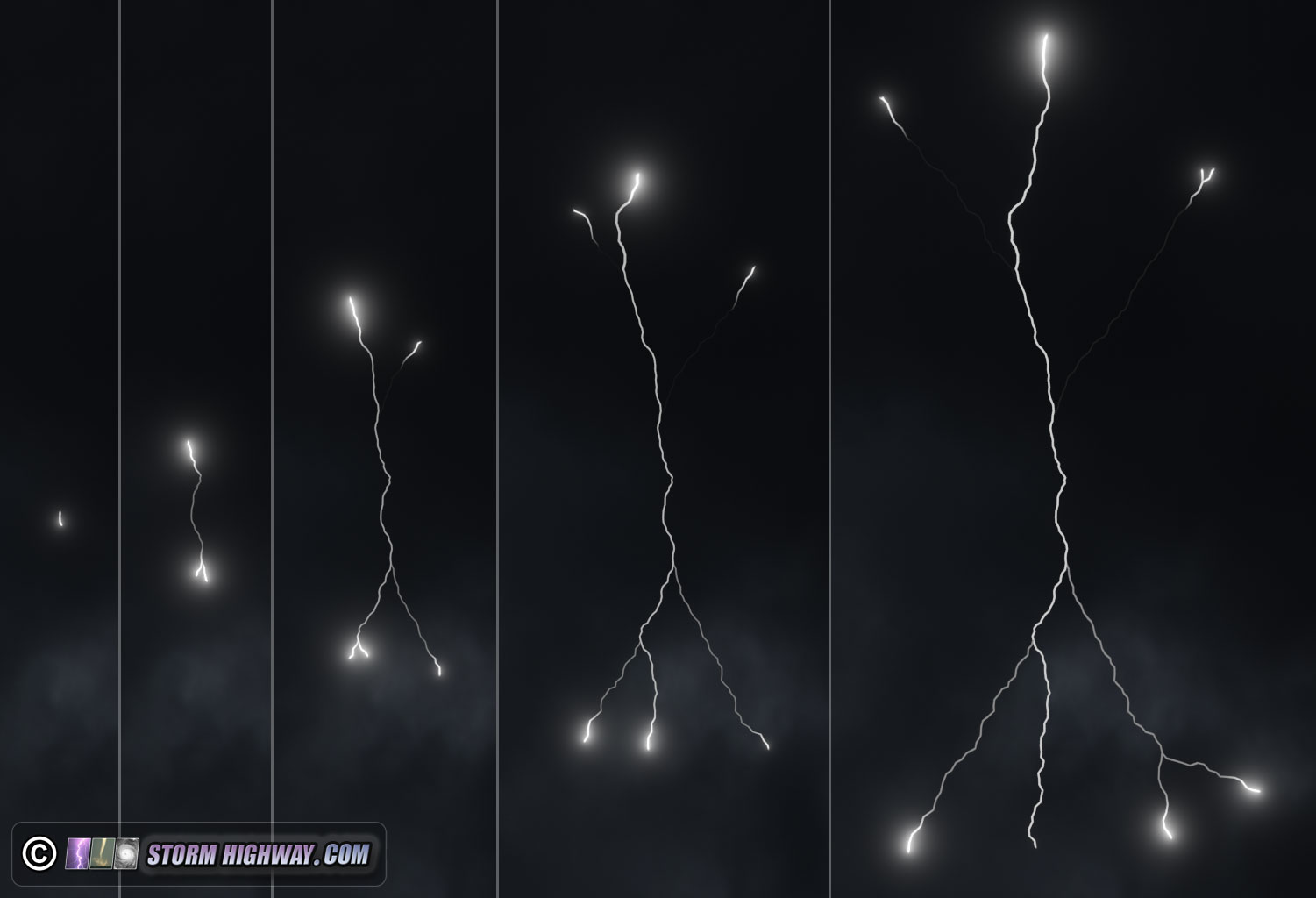
A rendering of a lightning discharge as it starts and grows inside of a cloud. The bidirectional leader grows in opposite directions into regions of opposing charge. Here, the negative leaders are growing downward and the positive leaders upward.  Branches Branches
The parts of the stepped leader paths that are not part of the main lightning channel. They are only illuminated during the first return stroke of a lightning flash, and are somewhat dimmer than the main channel. Branches create their own thunder, and since they extend away from the main channel in all directions, branches are often heard first as a sharp, crackling peal immediately before the loud crash from the main lightning bolt. CG
ChannelThe narrow path of ionized air in which the lightning flash current flows. Lightning channels are created by the propagation of leaders. It is illuminated brightly during the return stroke. 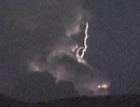 Cloud-to-Air Cloud-to-Air
Referring to a flash (or a portion of a discharge) from a cloud into clear air. Technically speaking, all cloud-to-ground lightning strikes contain 'cloud-to-air' components in the many branches that extend away from the main channel and terminate abruptly in mid-air. However, the most visually dramatic examples of cloud-to-air lightning occur when a long, bright lightning channel jumps out of the side of a cumulonimbus cloud and terminates in the clear air surrounding the storm (see photo at right). Cloud-to-Cloud (CC)Referring to a (rare) flash between two separate convective towers, mainly within a cluster of closely-spaced storms. Not to be confused with Intracloud lightning which refers to a discharge within a single cloud.  Cloud-to-Ground (CG) Cloud-to-Ground (CG)
Referring to a flash between cloud and ground (pictured at right) when one end of the in-cloud bidirectional leader descends to the ground. Cloud-to-ground flashes can be positive or negative. ConvectionThe process whereby warm air rises in columns upwards through cooler surrounding air. Convection is a big part of the 'engine' in thunderstorm development, pulling massive volumes of moisture (water vapor) in warm air into the cooler air above, allowing condensation of the water vapor into towering storm clouds ( cumulonimbus). Convective activity is likely to occur when the atmosphere is unstable and/or when a strong 'forcing element' such as a cold front is present (a cold front acts like a horizontal 'wedge' as it moves, forcing air ahead of it to rise). Thunderstorm activity is also sometimes called 'convective' activity. Corona DischargeA slow, steady discharge streaming off of a point or edge of an object in the presence of high opposing electrical charge. Corona discharge is usually visible as a small, slightly glowing 'spray' extending out into the air. On a small scale, corona discharge can equalize opposing electrostatic charges before full electrical breakdown occurs and a spark jumps. On a thunderstorm-scale level, corona discharge can occur from objects on the ground underneath the cloud's charge region. However, this rate of 'current' leak is extremely miniscule or even nonexistent in comparison to the rate and magnitude that the gigantic storm cloud is generating the voltage. Therefore, corona discharge on the ground doesn't even in the slightest bit prevent a lightning strike from occuring.
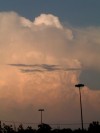 Cumulonimbus Cumulonimbus
A thunderstorm cloud (pictured at right). Cumulonimbus can tower over 60,000 feet (over 11 miles) up into the sky. Smaller cumulonimbus (30,000 feet) can still produce lightning, high winds, heavy rain, and sometimes tornadoes. When a cumulonimbus cloud reaches the top of the troposphere, its top will flatten and spread out into an ' anvil' shape. Cumulonimbus clouds are the product of strong convective activity. A rapidly growing cumulonimbus cloud's upper edges will usually look hard and rounded, like cauliflower, as it protrudes skyward:
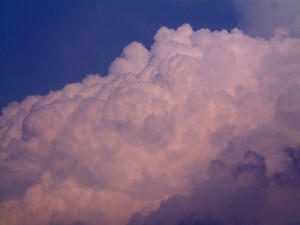 Cumulus Congestus Large, towering, isolated cumulus clouds that often precede or signal the potential for cumulonimbus and thunderstorm development. Some cumulus congestus clouds produce rain showers. Dart leaderA fast negative leader that retraces an existing lightning channel. Dart leaders, named for their rapid movement, are triggered by recoil leaders on a decayed positive leader branch. When a dart leader in a cloud-to-ground lightning channel reaches the ground, it will result in a subsequent return stroke in the existing channel. Cloud-to-ground lightning flashes can contain many dart leader-triggered return strokes. Dendritic
Having a structure like a tree (trunk and branches).
DischargeThe flow of current down the lightning channel that equalizes the charge difference between two regions of opposing charge inside a thunderstorm. FaultA short circuit in an electrical system.
FlashReferring to an entire lightning event from beginning to end.
FlashoverA fault on an electrical power line caused by a breach of an insulator by an arc through the air, usually used to describe those triggered by a lightning strike.  Fulgurite Fulgurite
Brittle, glassy formations caused by a lightning strike to sandy soil. The lightning heats the soil and fuses the
soil particles together surrounding the path of the channel, resulting in a hollow tube-like formation shaped like the section of lightning that formed it (pictured at right). Artificial fulgurites have been created using man-made lightning in laboratories. The word fulgurite comes from fulgur, the Greek word for lightning. 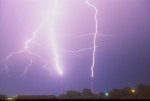 Ground-to-Cloud Ground-to-Cloud
Referring to a flash between cloud and ground initiated by an upward moving leader, usually occuring off of towers (pictured at right), mountains, and tall buildings. (see Lightning Classifications) Heat LightningA colloquialism referring to distant flashes of lightning barely visible on the horizon from faraway thunderstorms. Named so because it is often seen on hot, muggy nights, when conditions are favorable for thunderstorm development. 'Heat lightning' often is early warning sign that storms are approaching, because the lightning you see may be moving your way.
InstabilityA condition in the atmosphere where a layer of warm, moist air near the earth's surface is situated below a layer of cooler, drier air above it. Warm air is lighter than cool air, and its bouyancy makes it tend to rise upward in columns in a process called convection. Convective activity often results in thunderstorms.
Atmospheric instability is created any time a warm, moist layer of air is given the potential energy to rise upward through the cooler air. Most instability is created when the sun heats the earth's surface, which in turn heats the atmosphere near the ground. The sun's heating is also called 'diurnal' heating. Southerly winds can also create instability at non-sun-heated locations by transporting warm, moist air from one location to another (called warm advection), such as from the Gulf of Mexico to the mountains of West Virginia.  Intracloud Lightning Intracloud Lightning
Referring to a flash where the bidirectional leader stays entirely within a cloud, the most common type (pictured at right). The channel is normally obscured from view, and the flash appears to the observer as a sheet of light in the sky, therefore it is often called Sheet Lightning. (See Sheet Lightning.) IonizationThe process by which air becomes conductive. It is caused by a tremendous charge difference between two regions of opposite charge, and in the case of lightning it is the process that starts the flash. The electrons in the negatively charged region are so strongly attracted to the positively charged region that they begin to move through the air towards the opposing charge and create a conductive channel. The ionized channel is a conducting path for the lightning flash. Also called electrical breakdown. (See Leader, Stepped leader) KeraunomedicineA division of medical study pertaining to lightning injuries.
Leader
Lightning Protection SystemA system of rods, cables and groundings designed to intercept a strike and divert it safely to ground, avoiding structural damage to buildings, boats, and other vulnerable objects. A lightning protection system consists of metallic rods, heavy-duty cable, and a solid grounding terminal. The cable connects the lightning rods to ground. Lightning rods do not attract lightning, they simply provide a safe path for the lightning current to flow. See also Lightning Protection Systems. Power FlashA bright electrical arc from power lines, transformers, or other electrical equipment, usually used to describe those caused by lightning, tornadoes, high winds, or winter weather. (See also How Lightning Causes an Electrical Fault) Rain ShaftA distinctly visible, isolated column of rain falling from a cumulus congestus or cumulonimbus cloud. Cloud-to-ground lightning strikes often occur mostly inside or close to a rain shaft.
 Return StrokeThe intense flow of current ( flash) through a cloud-to-ground channel when its descending leader contacts the ground. The return stroke is brightly illuminated, and is the source of loud thunder. The first return stroke in a cloud-to-ground lightning flash is the only one that is branched. Many times there will be more than one return stroke down the same channel (see animation at right), making the lightning seem to flicker. (See Streamers) Sferics
Sheet Lightning
Shock WaveThe rapid expansion if air caused by the sudden and extreme heating of the air in a lightning channel during a return stroke. The shock wave continues outward for a few feet, moving faster than the speed of sound, and then slows to a sound wave, heard as thunder. The shock wave from an extremely close lightning strike can knock a person off his/her feet, and cause hearing damage and/or other injury. These shock waves can also damage objects directly struck or nearby objects. (See Thunder) Sprites and JetsElectrical flashs that occur high above active thunderstorms. They have been found to occur in conjunction with and/or as a reaction to a normal cloud-to-ground lightning flash. They are swift and faintly lit, making them almost invisible to the naked eye. Observations of sprites and jets have been made by placing a telescope on a high mountain and aiming it above thunderstorms occuring hundreds of miles away. For more information and photos on sprites and jets, check the Lightning Links page. St. Elmo's FireName given to a faint, soft blue-green glow around objects (particularly on airplanes or the masts of ships) during a thunderstorm. St Elmo's fire is thought to be a form of corona discharge caused by the high electrical potential created by a thunderstorm. The presence of St. Elmo's Fire on objects on the ground often indicates that a very close or direct cloud-to-ground lightning strike is imminent. Stepped LeaderThe name for negatively-charged leaders. Negative leaders split into more and more branches as they propagate. In the case of a cloud-to-ground flash, the branch that reaches an upward-moving leader from an object on the ground first becomes the path for the return stroke. The stepped leader is named so because its propagation of negative leaders move in in steps, forging through the air in short bursts. The stepped leader of a cloud-to-ground flash is usually not apparent to the human eye because of its speed and closeness in time (a small fraction of a second) to the bright return stroke. However, playing video of cloud-to-ground lightning strikes in slow-motion can sometimes reveal part of the stepped leader just before it connects to the ground. High-speed cameras operating at high frame rates can easily capture stepped leaders:
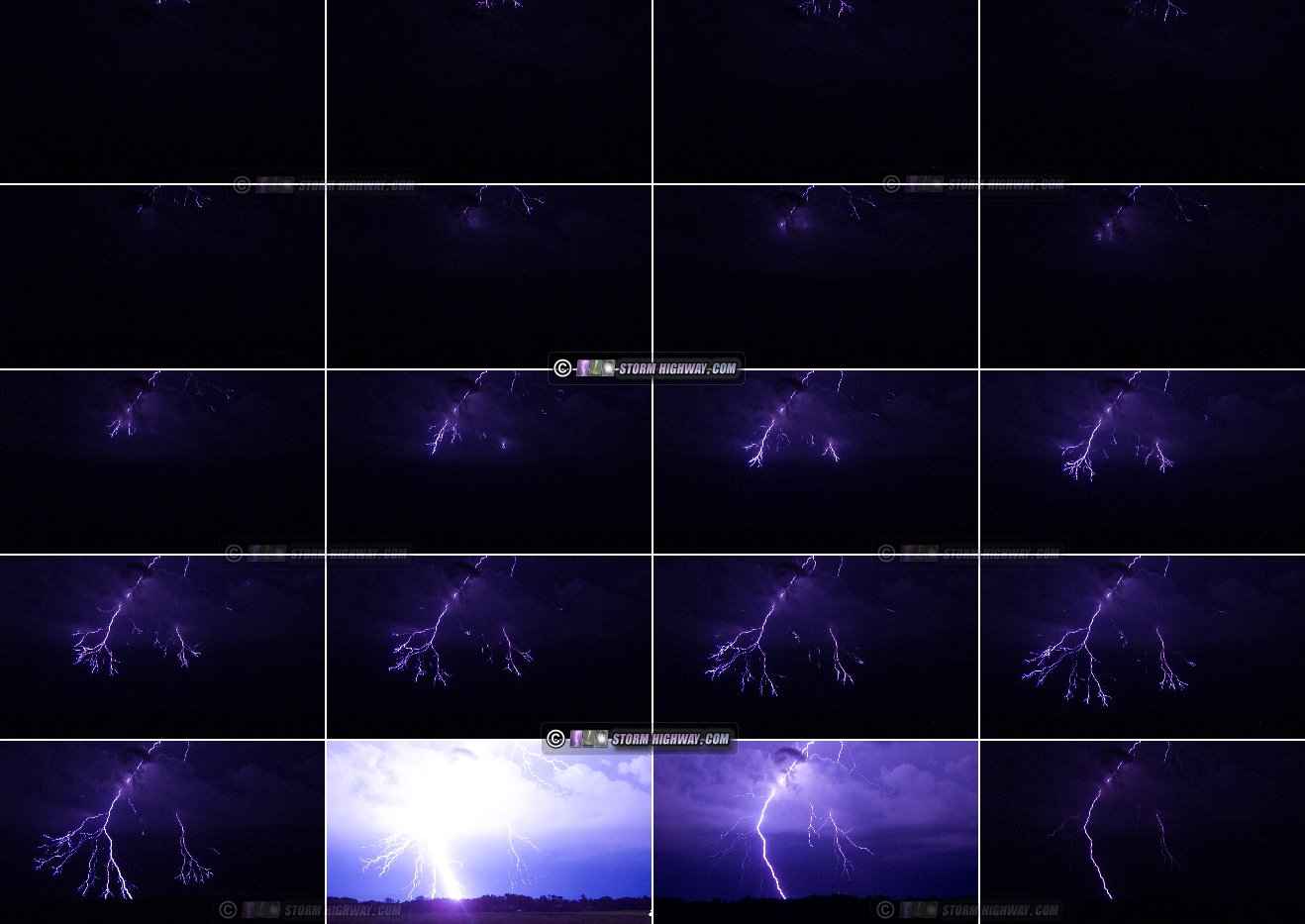
From high-speed video at 1,500 FPS of a cloud-to-ground strike near Trenton, Illinois: The stepped leader descends, followed by the bright return stroke in the last 3 frames. (See Ionization, Cloud-to-ground discharge) Streamers
This term has multiple meanings in the field of lightning science. Sometimes it is used to refer to the upward connecting leaders that develop on ground-based objects preceding a cloud-to-ground lightning flash. More often, it is used to describe part of the negative leader propagation process the occurs as new leader segments develop.
Strike Point
StrokeReferring to a return stroke, the intense flow of current through a lightning channel once a leader connects to the ground. ThunderThe sound waves produced by the explosive heating of the air in the lightning channel during a return stroke. It originates as shock waves close to the channel, and moves radially away from the channel. Thunder changes in pitch with varying distances from the channel. The closer one is to the lightning flash, the more high-pitched
and 'crackle-sounding' the thunder. The further away, the more low-pitched and 'boom-rumble' sounding it is. Thunder rumbles and crackles because the lightning channel is crooked and jagged, causing the sound waves to arrive at the hearer at different times and directions. If lightning strikes closer than around 300 feet, the observer will hear one loud, startling, high-pitched bang which is not 'sound wave' thunder, but the shock wave, sometimes preceded by a faint crackling noise. (See Shock Wave) For more detailed information on thunder, visit the Thunder Center. ThundersnowA heavy snowstorm with lightning and thunder, or a lightning discharge during wintry weather.
Voltage Gradient(Sometimes referred to as 'Ground Current') The surge of voltage through the ground raidially outward from the lightning strike point. The voltage gradient can electrocute anyone standing on the ground close to a lightning strike, often the cause of lightning injuries to people or animals who are near a lightning strike but are not directly hit. The reason that standing under or near a tree during a storm is dangerous is due mainly to the voltage gradient. Even if the main lightning channel flows entirely through or along the tree and does not jump over and hit whoever is standing there, the resulting huge surge of current through the ground surrounding the tree will give a nasty shock to anyone touching the ground nearby. The reason the term 'gradient' is used is because the voltage in the ground is lower with increasing distance from the strike point.
 About the Author: Dan Robinson has been a storm chaser, photographer and cameraman for 33 years. His career has involved traveling around the country covering the most extreme weather on the planet including tornadoes, hurricanes, lightning, floods and winter storms. Dan has been extensively published in newspapers, magazines, web articles and more, and has both supplied footage for and appeared in numerous television productions and newscasts. He has also been involved in the research community, providing material for published scientific journal papers on tornadoes and lightning. |
GO: Home | Storm Chase Logs | Photography | Extreme Weather Library | Stock Footage | Blog
Featured Weather Library Article:
|